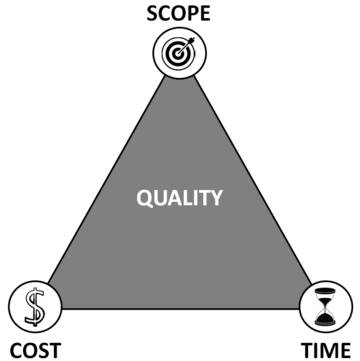Iron Triangle of Project Management
Contents |
Abstract
The roles of a project manager are numerous and one important role in attaining project success by balancing the competing constraints on a project with the resources available [1]. Without constraints, that would be a simple task and all projects would be good, fast, and cheap. Unfortunately, that is not the case as most projects must operate within some important boundaries concerning, scope, time, and cost. The interrelation of these components can make the difference between project success and failure and maintaining a balance between the three factors is therefore essential. The iron triangle is a model of these project elements and emphasizes that a change in one factor invariably affects the others. The theory helps project managers better understand the trade-off among these main constraints of project management. Even though the constraints of the iron triangle are a decent indicator regarding project management success, it is not necessarily the only marker of overall project success. The project scope can be delivered on time and within budget but ultimately result in an unsuccessful project because there are various other factors that help determine the effectiveness of a project. This article will describe the essence of the iron triangle, how project managers can apply the concept in practice, and the main limitations of the theory.
Big idea

Portfolio, program, and project management all operate in parallel and provide a structured way to align and effectively carry out organizational strategies. However, there is a difference in their focus and contribution to the attainment of strategic objectives and the theory regarding the iron triangle is primarily associated with project management. [3]
Project management is the application of knowledge, skills, tools, and techniques to meet a projects’ requirements. Effective project management consequently helps organizations to increase chances of success and meet business objectives. Poorly managed projects, on the other hand, may result in missed deadlines, cost overruns, and poor quality projects. [1]
The iron triangle (also called the project management triangle) is a concept based on the triple constraints of project management and an important theory in the field. These constraints are limitations placed upon a project which the project manager and team must operate within. There can be various constraints on a project, but there are three essential constraints that operate on most projects. These constraints are scope, time, and cost. [4]
- Scope
- Defines the boundaries of the project and describes what the project must deliver. It includes the processes required to ensure that the project includes all the work required to complete the project successfully. The project scope is therefore about defining and controlling what is included in the project. The term “scope” can refer to either product scope or project scope. Product scope are the features and functions that characterize a product while the project scope is the work performed to deliver a product with some specified features. [1][4]
- Time
- A specific time frame or deadline within which the project must be completed. This includes milestones and deadlines for each project phase.[4]
- Cost
- The budget that has been allocated for the project which limits the total expense. It includes all financial resources available to complete the project within the prearranged scope. The constraint includes money for work force, materials, quality control and more.[4]
The iron triangle is simply a model illustrating the relationship between these three constraints, showing that no constraint is independent of the others. If any one of them changes, at least one other variable will also change to restore balance to the project.[5] Therefore, the theory is essentially about the trade-offs between these constraints that form the end-points of the iron triangle. The trade-off dynamics of the constraints can be described by the following relationships, where the up-arrow (↑) denotes increase and the down-arrow (↓) denotes decrease:[6]
- Scope ↑ ⇒ * Time ↑ * Cost ↑
Application
Limitations
Annotated bibliography
[?] https://strategyzer.com TEXT
[?] BOOK TITLE TEXT
References
- ↑ 1.0 1.1 1.2 P.M.I. (2017). A Guide to the Project Management Body of Knowledge (6th ed.). Project Management Institute.
- ↑ Heagney, J. (2011). Fundamentals of Project Management (4th ed.). AMACOM.
- ↑ The Standard for Program Management (Fourth edition). (2017). Project Management Institute.
- ↑ 4.0 4.1 4.2 4.3 Everitt, J. (2020, May 25). Understanding The Project Management Triangle. Wrike. https://www.wrike.com/blog/understanding-project-management-triangle/
- ↑ Wysocki, R. K. (2019). Effective Project Management: Traditional, Agile, Extreme, Hybrid (8th ed.). Wiley.
- ↑ Van Wyngaard, C. J., Pretorius, J.H.C.,Pretorius, L. Theory of the Triple Constraint – a Conceptual Review. Retrieved February 16, 2021, from https://www.academia.edu/8294762/Theory_of_the_Triple_Constraint_a_Conceptual_Review.